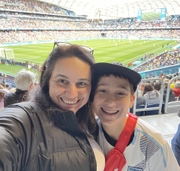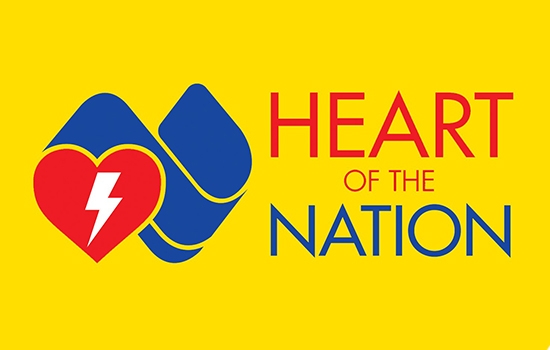
An AED can deliver a life-saving shock
Every 15 minutes, someone living in Australia experiences a cardiac arrest. That’s around 88 people every day.
A sudden cardiac arrest can happen to anyone, at any time, and research shows that the chance of survival outside of a hospital setting is incredibly low. We can help change this.By taking quick and informed bystander action, with the support of an automated external defibrillator (AED), you can help to save someone’s life.Do you know how shockingly simple AEDs are to use?
What to do if someone is in cardiac arrest
If you think someone is in cardiac arrest, follow the steps of Call, Push, Shock, also known as the Chain of Survival.
Remember, any attempt at resuscitation is better than no attempt and your quick action can give them the best chance of survival.
Call – Starting the Chain of Survival
Learn about calling emergency services and how to assess the situation. The operator will take you through what to do, including how to perform CPR.
Push – How to do CPR
Learn how to perform CPR. You do not have to be qualified and any attempt at resuscitation is better than none.
Shock – Using an AED
Learn how to administer life-saving shocks. AEDs are designed to be easy to use (even with no training) and safe for both the user and the patient.

What is a sudden cardiac arrest?
- A sudden cardiac arrest is when a person’s heart suddenly stops beating.
- It usually happens when there is a problem with the heart's electrical system, stopping the heart from pumping blood around the body.
- During cardiac arrest, a person will be unresponsive and not breathing (or not breathing normally).
.png?format=pjpg&auto=webp)
What is an automated external defibrillator (AED)?
- An AED is a portable electronic device that can detect life-threatening abnormal heart rhythms.
- AEDs are smart and will only deliver a shock if it is necessary.
- AEDs are designed to be easy to use and will give simple step-by step instructions. This means anyone can use an AED even if you’ve never seen or used one before.
Shocker stories
Meet Anastasia, cardiac arrest responder
Anastasia recalls the cold Tuesday evening when she witnessed a man lying unconscious during a social game of soccer.
“I was very happy to help by giving CPR but there was an element of fear about starting chest compressions, and uncertainty if I was doing it right. The AED was the one thing that provided an immense sense of support and reassurance."
Meet Daniel, cardiac arrest survivor
Daniel’s gym session started like any other with some light stretches and his favourite playlist. The Adelaide father of three felt well as he settled into his run on the treadmill, totally unaware that just six minutes later he would go into cardiac arrest.
“I just dropped to the ground,” explains Daniel. “My heart stopped, and I wasn’t breathing for over 12 minutes.”

The moment I saw the AED, I felt the biggest sense of relief. I heard the machine’s voice talk me through what I needed to do and suddenly I felt back in control.
Anastasia Georgiou
Cardiac arrest responder
Tools and resources
How to find an AED near you
During a cardiac arrest, finding an AED is a race against time. But in the chaos of the moment, it’s hard to navigate with panic setting in. The first step is always to call triple zero (000). Once you have called, you can use the Heart of the Nation app to help you locate up to 10 registered AEDs within five kilometres of your location, anywhere in Australia.

Resources for South Australians
Changes to AED legislation
South Australia will become the first state to mandate the installation and registration of AEDs, with the South Australian Automated External Defibrillators (Public Access) Act 2022 scheduled to take effect from January 1, 2025.
Understand the requirements of the Act, how it will be implemented and more on the SA Health website.
Be a GoodSAM responder
In South Australia, SA Ambulance Service (SAAS) has partnered with GoodSAM to help save more lives. GoodSAM is an alert system that uses a phone app to notify registered responders – like off-duty health professionals and first-aiders – if a cardiac arrest occurs near them.
Learn more about the program and how to register as a GoodSAM responder on the SAAS website.
Share these social media posts
Frequently asked questions
What is a cardiac arrest?
A cardiac arrest is when a person’s heart stops beating. It can happen suddenly and usually occurs when there is a problem with the heart's electrical system, stopping the heart from pumping blood around the body. During a cardiac arrest, a person will be unresponsive and not breathing (or not breathing normally).
A cardiac arrest is a medical emergency but quick action from bystanders by performing CPR and using an AED can improve a person’s chance of survival.
What are the signs and symptoms of a cardiac arrest?
A cardiac arrest happens suddenly and rapidly. It often occurs with no warning. The person in cardiac arrest will:
- Collapse and fall to the ground
- Lose consciousness and become non-responsive
- Not be breathing normally or not at all – it may sound like they are choking, gasping or gurgling.
What is the difference between a heart attack and a cardiac arrest?
A cardiac arrest is very different to a heart attack. During a heart attack, the person is conscious, breathing and can call out for help.
During a cardiac arrest, the person is not conscious, not breathing normally or at all, and cannot cry out for help.
Sometimes a heart attack can lead to a cardiac arrest. If you or someone is having a suspected heart attack, getting help as soon as possible can help prevent a cardiac arrest.
Both heart attacks and cardiac arrests are medical emergencies. Remember to call Triple Zero (000) immediately. The operator will be able to ask questions to determine what is happening and send help.
What is cardiopulmonary resuscitation (CPR)?
CPR is a combination of mouth-to-mouth rescue breathing and chest compressions.
CPR helps to keep blood and oxygen circulating to the brain of a person whose heart has stopped beating, until the heart can be restarted.
Compressions-only CPR is CPR without rescue breaths (also known as ‘hands only CPR’). Both types of CPR double the person’s chance of survival.
CPR alone does not restore a normal heart rhythm. It does help keep the heart in a state where the AED has a greater chance of being able to do its job.
Remember, any attempt at resuscitation is better than none.
Can you hurt someone when performing CPR?
Chest compressions are easy and safe. Any attempt at resuscitation, even one that isn’t perfect, is always better than no attempt. Ambulance call takers will be on the phone and can guide you through the process if you need any help. The person you are helping is unconscious and cannot feel any pain.
Do I need formal training to perform CPR?
No, you don’t need formal training to perform CPR. Any attempt at resuscitation is better than none. Just remember, Call, Push, Shock. The 000-call taker will guide you through CPR. The key is to push hard and fast on the chest.
How am I protected as a responder?
Any resuscitation attempt is better than none. Most states have civil liability laws that may provide protections to bystanders that perform CPR under certain conditions. When you call 000, the 000-call taker will guide you through next steps, including CPR if you don’t know what to do.
Can I register as a responder?
Most states have an alert system that uses a phone app to notify registered responders – like off-duty health professionals and first-aiders – if a cardiac arrest occurs near them.
These responders can provide CPR while an ambulance is on the way.
Register to become a responder in your state:
- ACT and WA: http://www.stjohnwa.com.au/ambulance-and-health-services/community-first-responder
- NSW: https://www.ambulance.nsw.gov.au/get-involved/goodsam
- VIC: https://www.goodsamapp.org/AV
- SA: https://www.goodsamapp.org/saas
- TAS: https://www.health.tas.gov.au/goodSAM
- Northern Territory: https://www.stjohnnt.org.au/about-us/community-resources
What is an automated external defibrillator (AED)?
An AED is a portable electronic device that detects life-threatening abnormal heart rhythms and delivers an electrical shock if needed.
AEDs detect if the heart has a shockable rhythm. They only deliver a shock if required— an AED will not shock someone when a normal heartbeat is detected, or there is no heartbeat at all.
AEDs also give simple step-by-step instructions. This means anyone can use an AED, even if you’ve never seen or used one before.
Why are AEDs important?
CPR alone does not restore a normal heart rhythm. It does help keep the heart in a state where the AED has a greater chance of being able to do its job.
When both CPR is performed and an AED is used within the first 3 to 5 minutes of a cardiac arrest, survival rates can increase to 60-70%.
Can you hurt someone by using an AED?
No, you cannot harm yourself or others by using an AED. An AED automatically analyses the heart’s rhythm and will only deliver a shock to someone if they require it.
Do I need formal training to use an AED?
No, AEDs are designed so that anyone can use them in an emergency. Just turn it on and follow the prompts.
What do I need to consider when purchasing an AED?
When purchasing an AED, you might like to consider the following things:
- Warranty period.
- Lifetime of batteries and pads - how often will you have to replace them?
- Size and weight of the device - is it easy to pick up and carry?
- What features does the device have, and what are your needs (eg, languages, battery and pad expiration, child mode).
- What support and training are offered by the retailer/distributor?
- Does the distributor offer an after-sales monitoring or maintenance service to ensure your device is maintained and working at all times.

|
Heart of the Nation is the Heart Foundation’s partner for AED and CPR awareness, training and advocacy. Together, we are committed to exploring ways to improve survival rates from, and reduce the incidence of, out-of-hospital cardiac arrests in Australia, and bolstering community and Government action in relation to CPR and AED access and use. |
.jpg?format=pjpg&auto=webp)


.png?width=550&height=auto&format=pjpg&auto=webp)
